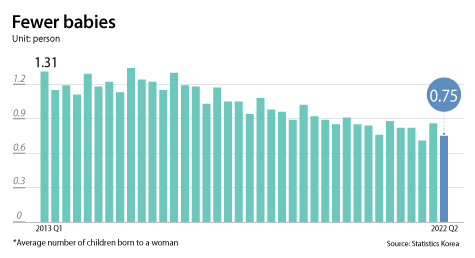Korea's fertility rate drops for sixth straight year
![An array of baby clothes at a baby fair in Suwon, Gyeonggi in March [YONHAP]](https://koreajoongangdaily.joins.com/data/photo/2022/08/26/a3e30af2-db1e-4fbc-96a1-5077eef4fb3b.jpg)
An array of baby clothes at a baby fair in Suwon, Gyeonggi in March [YONHAP]
The total fertility rate – the average number of births a woman is projected to give during her reproductive years – stood at 0.81 last year, down from 2020’s 0.84, Statistics Korea announced Wednesday.
Korea’s total fertility rate has consistently dropped since 2015, when the figure was 1.24.
Korea has the lowest total fertility rate in the world, nearly half the average for the advanced economies that are members of the Organisation for Economic Co-operation and Development (OECD), which is 1.59.
A total fertility rate of at least 2 is needed to sustain a country’s population.
The Statistics Korea report said that Korea’s total fertility rate for the second quarter of 2022 dipped to 0.75, down 9.3 percent from a year earlier's 0.82.
It was the first time the total fertility rate for a second quarter was below 0.8. The total fertility rate for the fourth quarter of 2021 was 0.71.

Demographic experts say Korean couples try not to have babies at the end of a year out of fear they would be physically smaller than their peers. Koreans count their age from the turn of the New Year.
A total of 59,961 babies were born from April to June, 9.3 percent fewer on year. From January to June, there were 128,138 babies born, 6 percent fewer on year.
Some 260,600 babies were born in 2021, but at the current rate, Statistics Korea said the country might see fewer than 250,000 born this year. That’s nearly half the number of babies born in 2003, some 495,000.
There are 347,000 places in four-year Korean universities today, which means that over the next two decades, schools will be forced to undergo major downsizing.
If the current trend persists, Choi Seul-ki, a professor at the KDI School of Public Policy and Management, said there is a good chance Korea’s total fertility rate for 2022 will dip below the 0.8 benchmark, the first in the world.
Sejong had the highest total fertility rate out of all major cities and provinces last year, 1.28, followed by South Jeolla with 1.02. Seoul’s figure was 0.63, the lowest, and Busan's was 0.73.
“With Sejong,” said No Hyeong-jun, head of Statistics Korea’s Vital Statistics Division, “the total fertility rate was high there because there were many young couples who moved to live in a newly developed urban environment or because their offices relocated” to the city. No pointed out that there were many married women living in Sejong, unlike other metropolitans where a high portion of women are single.
Sejong, located about 125 kilometers (78 miles) south of Seoul, is Korea’s administrative capital. Over 70 government organizations and state-backed research institutes have moved to Sejong, mainly from Seoul, as part of a government initiative to balance regional growth.
The number of marriages in Korea has dropped for nearly a decade, as young people increasingly refuse to tie the knot due to job insecurities and expensive real estate. There were 47,734 married couples in the second quarter, down 1.1 percent on year and the 14th consecutive quarter that the figure shrank.
About 97 percent of births in Korea come from married couples, and, on average, it takes a married couple 2.5 years to give birth to their first child. On average, a Korean woman gives birth to her first child at age 33.4.
BY LEE SUNG-EUN [lee.sungeun@joongang.co.kr]










with the Korea JoongAng Daily
To write comments, please log in to one of the accounts.
Standards Board Policy (0/250자)